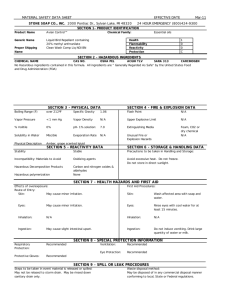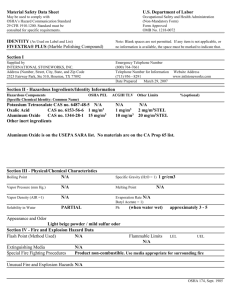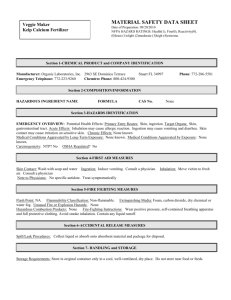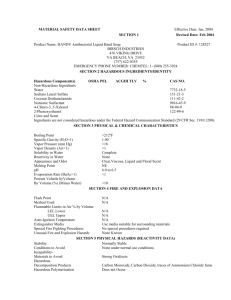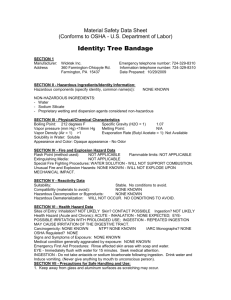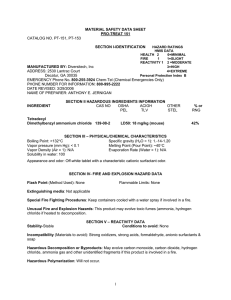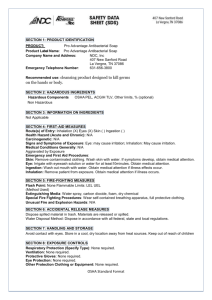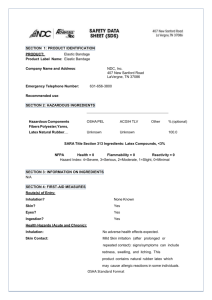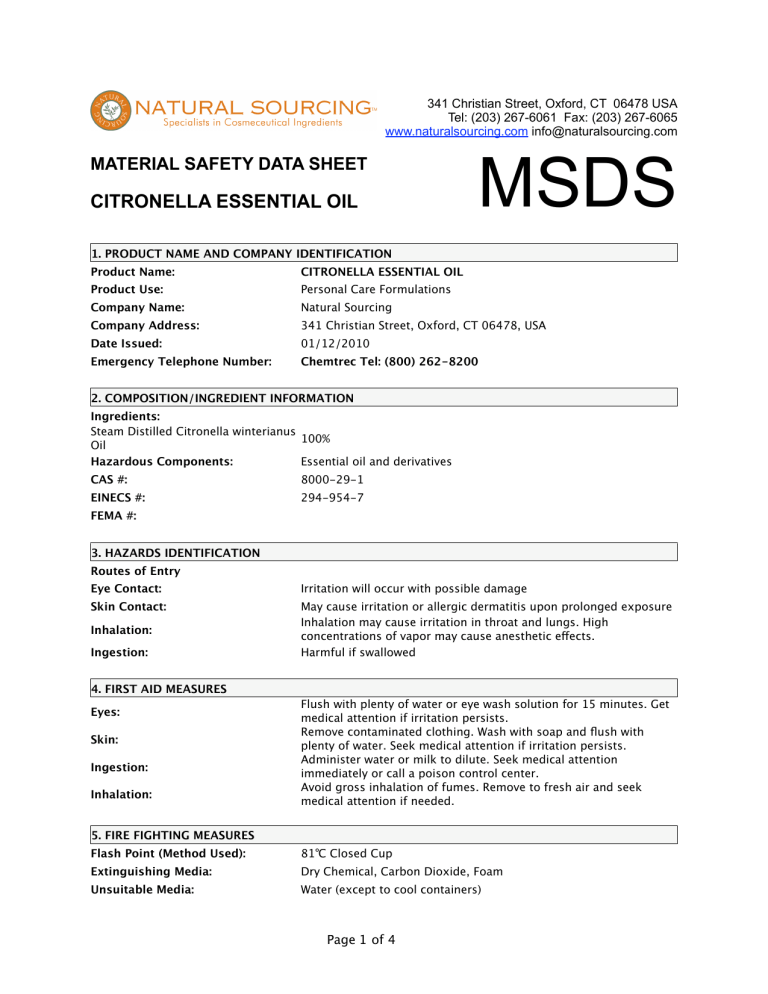
341 Christian Street, Oxford, CT 06478 USA Tel: (203) 267-6061 Fax: (203) 267-6065 www.naturalsourcing.com info@naturalsourcing.com MATERIAL SAFETY DATA SHEET CITRONELLA ESSENTIAL OIL MSDS 1. PRODUCT NAME AND COMPANY IDENTIFICATION Product Name: CITRONELLA ESSENTIAL OIL Product Use: Personal Care Formulations Company Name: Natural Sourcing Company Address: 341 Christian Street, Oxford, CT 06478, USA Date Issued: 01/12/2010 Emergency Telephone Number: Chemtrec Tel: (800) 262-8200 2. COMPOSITION/INGREDIENT INFORMATION Ingredients: Steam Distilled Citronella winterianus 100% Oil Hazardous Components: Essential oil and derivatives CAS #: 8000-29-1 EINECS #: 294-954-7 FEMA #: 3. HAZARDS IDENTIFICATION Routes of Entry Eye Contact: Irritation will occur with possible damage Skin Contact: May cause irritation or allergic dermatitis upon prolonged exposure Inhalation may cause irritation in throat and lungs. High concentrations of vapor may cause anesthetic effects. Harmful if swallowed Inhalation: Ingestion: 4. FIRST AID MEASURES Eyes: Skin: Ingestion: Inhalation: Flush with plenty of water or eye wash solution for 15 minutes. Get medical attention if irritation persists. Remove contaminated clothing. Wash with soap and flush with plenty of water. Seek medical attention if irritation persists. Administer water or milk to dilute. Seek medical attention immediately or call a poison control center. Avoid gross inhalation of fumes. Remove to fresh air and seek medical attention if needed. 5. FIRE FIGHTING MEASURES Flash Point (Method Used): 81℃ Closed Cup Extinguishing Media: Dry Chemical, Carbon Dioxide, Foam Unsuitable Media: Water (except to cool containers) Page 1 of 4 Fire fighters should wear positive pressure self-contained breathing apparatus. Toxic vapors may be released. Cool containers exposed Special Firefighting Procedures: to flame with water. Spray extinguishing media directly into base of fire. Unusual Fire & Explosion Hazards: None known Hazardous Decomposition Burning produces CO and CO2 Materials: 6. ACCIDENTAL RELEASE MEASURES (STEPS FOR SPILLS) Avoid ingestion Follow good industrial practice as to housekeeping, personal hygiene and avoidance of prolonged or repeated contact with the Personal Protection: skin or eyes. Wear eye protection, gloves and aprons. Ventilate area well or wear approved respirators. Eliminate all sources of ignition Ventilate area or wear approved respirators Prevent liquid from entering sewers Methods for Cleaning Up: Small spills can be wiped up with paper rags (place in closed metal waste container) Large spills can be absorbed onto non-flammable absorbent. Wash area with soap and water. 7. HANDLING AND STORAGE Handling Safe Handling: Avoid ingestion Follow good industrial practice as to housekeeping, personal hygiene and avoidance of prolonged or repeated contact with the skin or eyes. Wear eye protection, gloves and aprons. Ventilate area well or wear approved respirators. Storage Requirements for Storage Areas and Store in an area that is cool, dry, and well-ventilated. Do not Containers: expose to temperatures over 60℃. 8. EXPOSURE CONTROL/PERSONAL PROTECTION Threshold Limit Value: Not established OSHA Permissible Limit: Not established Provide adequate ventilation. Safety showers and eye wash stations should be located near work areas. Personal hygiene is an important work practice exposure control measure and the following general measures should be taken when working with or handling this material: Engineering Controls: Respiratory: (1) Do not store, use, and/or consume foods, beverages, tobacco products, or cosmetics in areas where this material is stored. (2) Wash hands and face carefully before eating, drinking, using tobacco, applying cosmetics, or using the toilet. (3) Wash exposed skin promptly to remove accidental splashes or contact with this material. Avoid casual breathing of vapors Ventilation: Local, mechanical exhaust in recommended Eye: OSHA approved safety glasses Work Practice Controls: Page 2 of 4 Skin: Wear gloves and clothing to avoid skin contact 9. PHYSICAL AND CHEMICAL PROPERTIES Physical State: Liquid, Oil Color: Clear yellow to pale brown Odor: Characteristic of lemon, herbaceous Vapor Pressure (mm Hg.): Not available Flash Point: 81℃ Boiling Point: + 215℃ Melting Point: NA Specific Gravity (H2O = 1): 0878 – 0.895 Refractive Index @ 25˚C: 1.4660-1.4750 Optical Rotation: -5° to 0° Solubility in Water: Insoluble 10. STABILITY AND REACTIVITY Stability: Incompatibility (Materials to Avoid): Conditions to Avoid: Hazardous Decomposition or Byproducts: Hazardous Polymerization: This material is stable under normal conditions Avoid contact with strong oxidizing agents and avoid hot work and sources of ignition on or near empty containers. Avoid contact with sparks, flame and heat. CO, CO2, smoke and unidentified organic compounds may be formed during combustion. Will Not Occur 11. TOXICOLOGICAL INFORMATION CAUTION: Liquid may be irritating to eyes and skin. ACGIH TLV: None established OSHA PEL: Irritancy: None established NTP Monograph: None established IARC Monograph: None established Oral LD50: > 5000 mg/kg [Rat] Dermal LD50: > 4700 mg/kg [Rabbit] Inhalation LC50: None established Not Available Sensitization: Not Available Phototoxicity: Not Available Carcinogenicity: Acute Toxicity Data: 12. ECOLOGICAL INFORMATION Mobility: Toxic to aquatic organisms, may cause long term adverse effects in the aquatic environment Low mobility in the soil Persistence: Not available Bio-accumulative Potential: Not available Aquatic Toxicity: 13. DISPOSAL CONSIDERATIONS Waste Disposal Methods: Dispose of according to local, state and federal regulations. Page 3 of 4 14. TRANSPORT INFORMATION Customs Rate Code: Land Transport: ADR/RID: Maritime Transport: IMDG: Air Transport: ICAO-TI/IATA-DGR: 3301 29 41 00 Class: 9 UN #: 3082 Packing Group: III Label Name: Environmentally Hazardous Substance, Liquid, N.O.S. Class: 9 UN #: 3082 Packing Group: III Label Name: Environmentally Hazardous Substance, Liquid, N.O.S. Marine Pollutant: Yes Class: 9 UN #: 3082 Packing Group: III Label Name: Environmentally Hazardous Substance, Liquid, N.O.S. 15. REGULATORY INFORMATION Federal & State Regulations: Other Regulations: TSCA 8(b) inventory: Citronella Oil OSHA: Hazardous by definition of Hazard Communication Standard (29 CFR 1910.1200). Other Classifications: WHMIS (Canada): DSCL (EEC): HMIS (USA): National Fire Protection Association (USA): Protective Equipment: Class B-3: Combustible liquid with a flash point between 37.8℃ (100℉) and 93.3℃ Class D-2A: Material causing other toxic effects (VERY TOXIC). R38: Irritating to skin R41: Risk of serious damage to eyes Health Hazard: 2 Fire Hazard: 2 Reactivity: 0 Personal Protection: h Health Hazard: 2 Flammability: 2 Reactivity: 0 Specific Hazard: Gloves Lab Coat Approved Vapor Respirator Splash Goggles 16. ADDITIONAL INFORMATION This information is provided for documentation purposes only. The complete range of conditions or methods of use are beyond our control therefore we do not assume any responsibility and expressly disclaim any liability for any use of this product. Information contained herein is believed to be true and accurate however, all statements or suggestions are made without warranty, expressed or implied, regarding accuracy of the information, the hazards connected with the use of the material or the results to be obtained from the use thereof. Compliance with all applicable federal, state, and local laws and local regulations remains the responsibility of the user. This safety sheet cannot cover all possible situations which the user may experience during processing. Each aspect of your operation should be examined to determine if, or where, additional precautions may be necessary. All health and safety information contained in this bulletin should be provided to your employees or customers. Page 4 of 4

